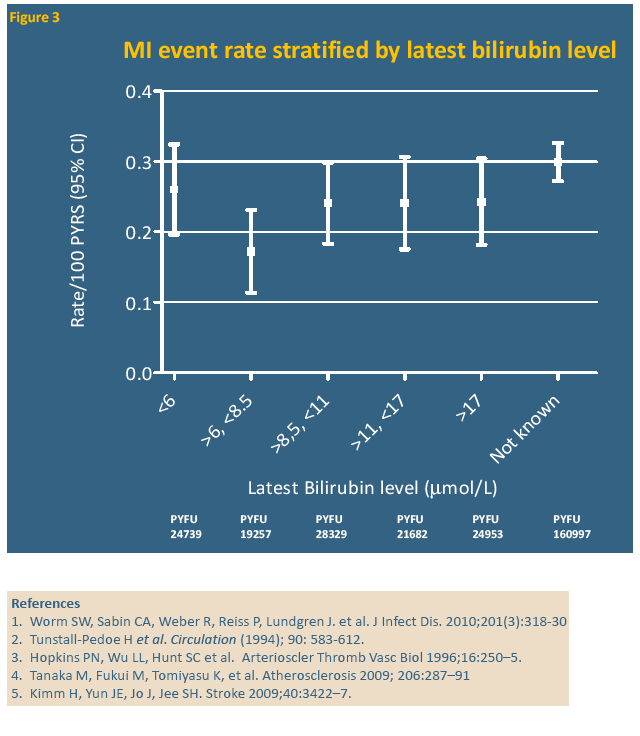 |
 |
 |
| |
D:A:D Sees No Link Between Atazanavir and Myocardial Infarction or Stroke
|
| |
| |
19th Conference on Retroviruses and Opportunistic Infections, March 5-8, 2012, Seattle
Mark Mascolini
Taking atazanavir did not raise the risk of myocardial infarction (MI) or stroke in a large D:A:D Study analysis [1]. The investigators believe these results suggest that previously identified associations between lopinavir or indinavir and MI do not mean all protease inhibitors (PIs) have this effect.
(From Jules: you could question comparing different ARTs from different time periods)
The earlier D:A:D analysis identified an association between PI duration and heightened risk of myocardial infarction [2]. This association held true for lopinavir and indinavir, but not for saquinavir or nelfinavir. Because the D:A:D Study now has enough follow-up data on people taking atazanavir, they conducted this analysis to evaluate possible associations between cumulative atazanavir exposure and myocardial infarction or stroke.
Follow-up started on the day of enrollment in D:A:D and continued until a new MI or stroke, death, 6 months after the last clinic visit, or February 2011.
Atazanavir takers did not differ substantially from those not on atazanavir in gender (26.5 versus 26.4 female), HIV transmission risk group (45.3% and 44.7% MSM), race (52.0% and 51.0% white), body mass index (66.9% and 68.4% between 18 and 26 kg/m(2)), or never-smokers (25.6% and 24.7%). The atazanavir group included higher proportions with a family history of cardiovascular disease (9.3% versus 7.8%), a previous cardiovascular event (3.0% versus 2.0%), diabetes (6.8% versus 4.5%), and a Framingham cardiovascular risk score above 20% (8.6% versus 5.7%). The atazanavir group had lower proportions of people between 20 and 29 years old (3.8% versus 6.3%) and 30 and 39 (21.0% versus 32.1%), and higher proportions between 40 and 49 (44.2% versus 37.2%), 50 and 59 (21.2% versus 15.7%), and 60 or older.
Through more than 300,000 person-years of follow-up, the researchers counted 844 MIs for an incidence of 2.80 per 1000 person-years and 532 strokes for an incidence of 1.76 per 1000 person-years. People taking atazanavir/ritonavir contributed 31,502 person-years and people taking unboosted atazanavir contributed 9611 person-years.
MI incidence varied from 2.8 per 1000 person-years in people with no atazanavir exposure to 2.0 per 1000 person-years in people with more than 3 years of atazanavir use. Stroke incidence was 1.7 per 1000 person-years in people who never took atazanavir and 1.7 in people with more than 3 years of atazanavir experience.
Statistical analysis adjusted for antiretroviral exposure and an array of demographic and clinical variables found no association between each additional year of atazanavir use and MI (relative rate [RR] 0.95, 95% CI confidence interval [CI] 0.87 to 1.05, P = 0.30) or stroke (RR 0.90, 95% CI 0.81 to 1.01, P = 0.07). That lack of association persisted in analyses limited to cohorts that had data on bilirubin levels.
Lack of association between atazanavir use and MI or stroke suggested to the D:A:D team "that previously reported associations in the D:A:D Study with lopinavir and indinavir are unlikely to reflect a class-wide association."
Although further statistical adjustment for latest bilirubin level did not alter these findings, the investigators noted that they had limited data on latest bilirubin. They suggested that their findings may be strengthened by inclusion of more people taking atazanavir for a longer time.
References
1. d'Arminio Monforte A, Reiss P, Ryom L, et al. Atazanavir-containing antiretroviral treatment is not associated with an increased risk of cardio- or cerebro-vascular events in the D:A:D study. 19th Conference on Retroviruses and Opportunistic Infections. March 5-8, 2012. Seattle. Abstract 823. http://www.retroconference.org/2012b/PDFs/823.pdf.
2. Worm SW, Sabin C, Weber R, et al. Risk of myocardial infarction in patients with HIV infection exposed to specific individual antiretroviral drugs from the 3 major drug classes: the data collection on adverse events of anti-HIV drugs (D:A:D) study. J Infect Dis. 2010;201:318-330. http://jid.oxfordjournals.org/content/201/3/318.long.
-----------------------------------------
Atazanavir (ATV)-Containing Antiretroviral Treatment is not Associated with an Increased Risk of Cardio- or Cerebro-Vascular Events (CVE) in the D:A:D Study
A d'Arminio Monforte1, P Reiss2, L Ryom3, W El-Sadr4, F Dabis5, S De Wit6, SW Worm3, A Phillips7, J Lundgren3,8, and C Sabin7
1Dipartimento di Medicina, Chirurgia e Odontoiatria, Clinica di Malattie Infettive e Tropicali, Azienda Ospedaliera-Polo Universitario San Paolo, Milan, Italy; 2Academic Medical Center, Division of Infectious Diseases and Department of Global Health, University of Amsterdam, The Netherlands;
3Copenhagen HIV Programme, Faculty of Health Science, University of Copenhagen, Denmark; 4ICAP-Columbia University and Harlem Hospital, New York, USA; 5Univ. Bordeaux, ISPED, Centre Inserm U897- Epidemiologie-Biostatistique,Bordeaux, France; 6CHU Saint-Pierre, Department of Infectious Diseases, Brussels, Belgium; 7Research Department of Infection and Population Health, UCL, London, United Kingdom; 8Epidemiklinikken M5132, Rigshospitalet, Copenhagen, Denmark








|
| |
|
 |
 |
|
|